What Are Best Substrates for Reptile Humidity?
If you’re looking to boost humidity for your reptiles, I’ve found that coconut fiber, sphagnum moss, and peat moss are top contenders. They retain moisture brilliantly and create cozy, tropical vibes. Bark chips add beauty and texture while keeping humidity in check, and soil blends offer a breathable environment. Having spent years styling my pet spaces on ExoTails, I can tell you that mixing some of these substrates can really transform a habitat. Curious about more options?
Quick Takeaways
- Coconut fiber offers exceptional moisture retention, creating a humid environment suitable for reptiles while providing an earthy aroma.
- Sphagnum moss retains moisture effectively and enhances aesthetics, making it ideal for maintaining humidity in reptile habitats.
- Peat moss is lightweight, pH neutral, and eco-friendly, making it a great choice for retaining humidity when mixed with other substrates.
- Bark chips add charm and contribute to humidity retention, providing a cozy environment for reptiles while enhancing the habitat’s visual appeal.
- Soil blends ensure breathable and moisture-retentive conditions, promoting reptile wellbeing while creating a lush, natural environment.
Coconut Fiber
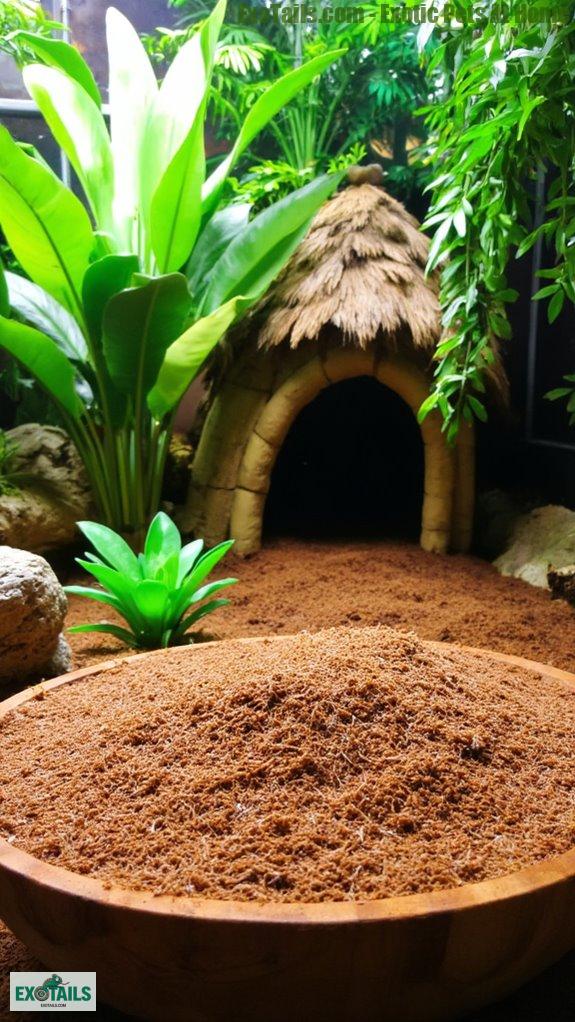
When it comes to creating the perfect humidity habitat for your scaly companion, coconut fiber stands out like a rock star at a talent show.
Coconut fiber is the ultimate superstar for achieving the ideal humidity habitat for your scaly friend.
Its moisture-retaining properties work wonders, letting you control humidity with ease. You’ll love its natural aroma; that earthy scent beats any air freshener, trust me!
While coconut fiber benefits your pet, consider coconut fiber alternatives like aspen shavings or bark chips. But, let’s be real—nothing rivals that tropical vibe of coconut fiber. Additionally, coconut fiber is one of the best substrate types for maintaining humidity levels in exotic pet habitats.
At ExoTails, I believe every reptile deserves a slice of paradise.
Sphagnum Moss
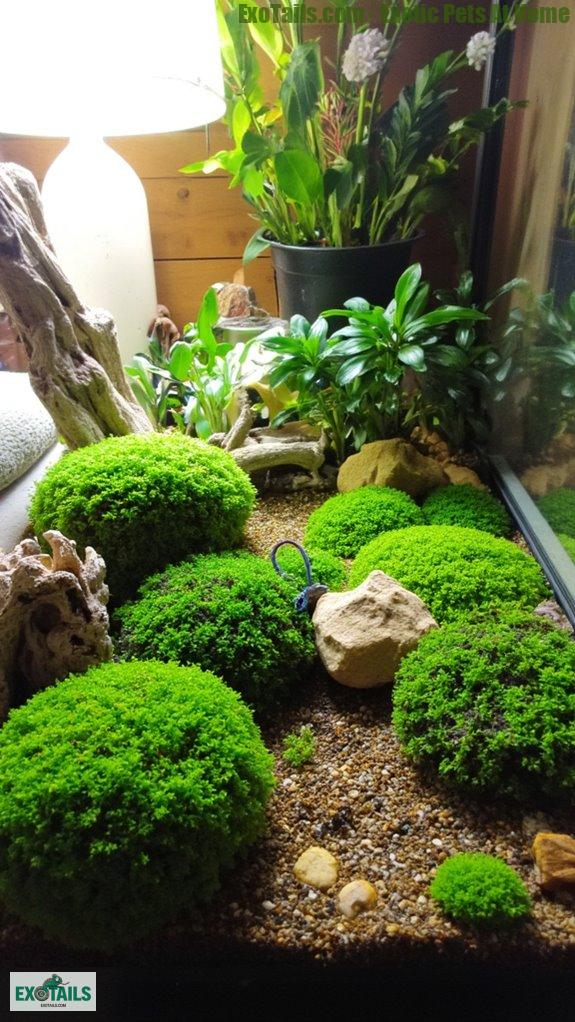
Sphagnum moss is like the versatile Swiss Army knife of substrates when it comes to maintaining humidity for your reptile buddy. Its moisture-retaining qualities are exceptional, offering fantastic sphagnum benefits.
Instead of wrestling with dry air, you’ll provide an ideal environment where your pet can thrive. Plus, moss maintenance is a breeze—just mist it occasionally, and it’ll stay fresh.
I created ExoTails because I love blending exotic pets with home decor. Who wouldn’t want a stylish habitat that looks great?
With sphagnum moss, you gain humidity control and design flair, creating a reptile paradise that’s hard to beat! Additionally, using this substrate can help create stress-reducing habitats that promote the overall well-being of your exotic pets.
Peat Moss
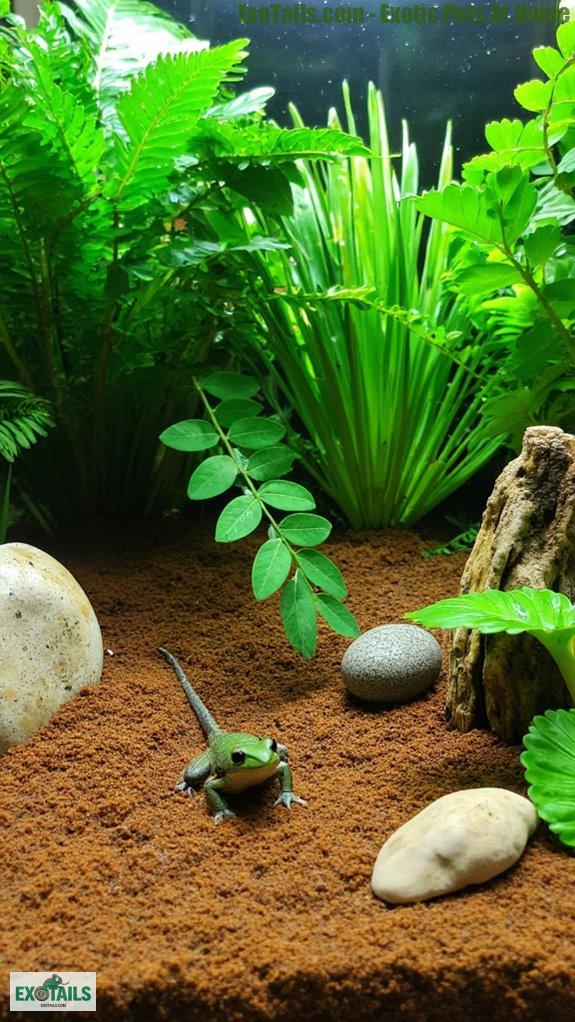
Peat moss is the underdog of reptile substrates, and let me tell you, it packs a punch when it comes to humidity control! I’ve seen its benefits firsthand in my exotic pet setups. Additionally, peat moss can be a great option for creating ideal enclosures that meet the humidity needs of semi-aquatic reptiles.
Here’s a quick look at why I love it:
| Benefit | Details | Maintenance |
|---|---|---|
| Humidity Retention | Keeps moisture locked in | Requires regular misting |
| pH Neutral | Safe for many reptiles | Mix with other substrates for balance |
| Lightweight | Easy to work with | Change every few months |
| Eco-Friendly | Sustainable and biodegradable | Compostable when replaced |
Trust me, using peat moss makes all the difference!
Bark Chips
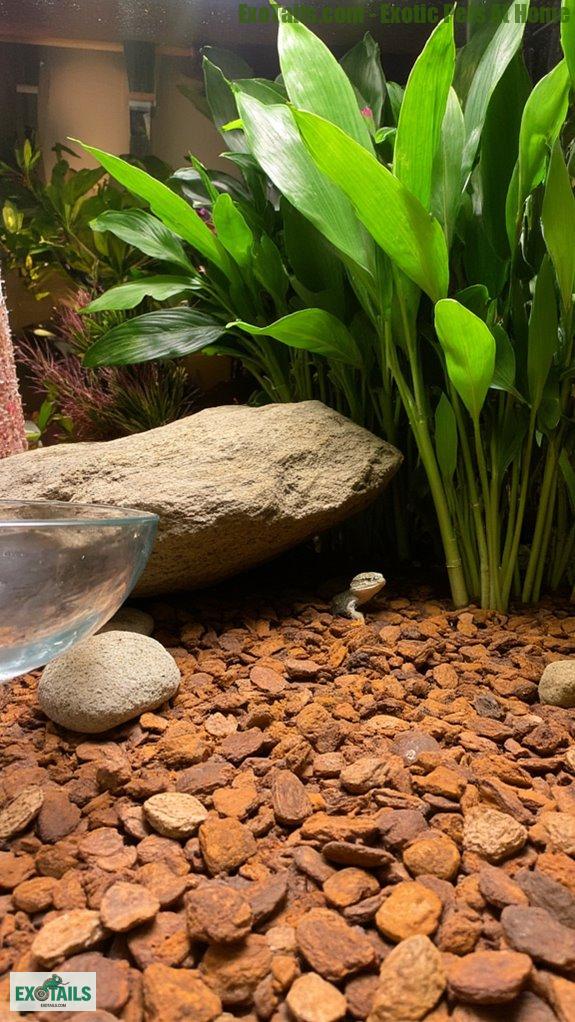
Bark chips might just be the unsung hero of reptile habitats, bringing a touch of natural charm to your setup.
Bark chips are the hidden gem for reptile habitats, adding natural beauty and charm to any setup.
When choosing bark chip types, options like pine or coconut add a robust texture. These chips not only look great but help maintain humidity levels too. Can you believe it?
The bark chip benefits come in handy for both aesthetic appeal and moisture retention, creating an environment your reptiles will appreciate.
After all, who doesn’t want their scaly friends to feel cozy? I know I do!
That’s why I created ExoTails, to share my love and knowledge of exotic pets and home decor.
Soil Blends
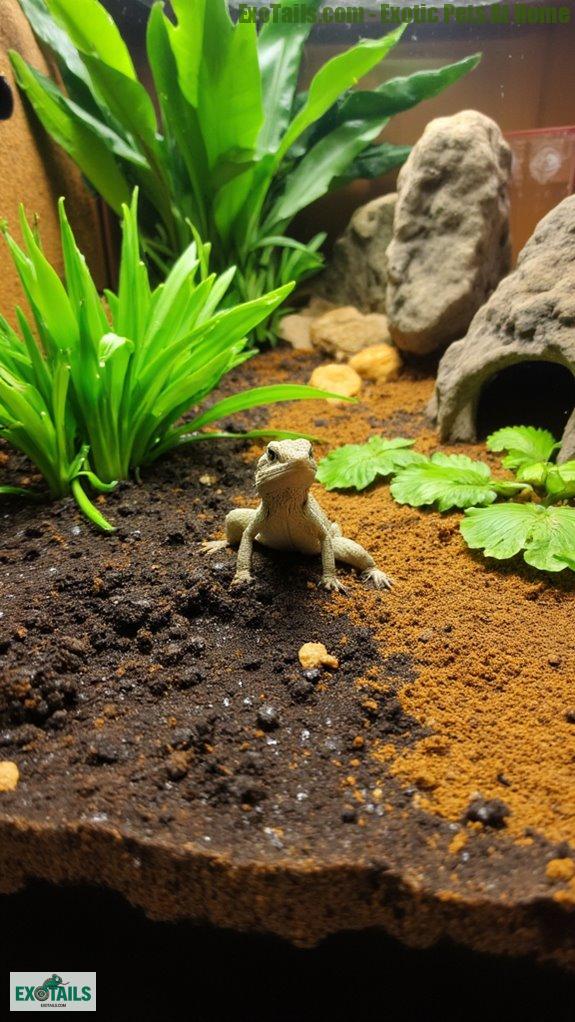
So, you’ve probably noticed that lots of reptile enthusiasts swear by soil blends, and I’m here to tell you they’re onto something incredible!
Soil blends offer fantastic soil texture and exceptional moisture retention, creating a cozy environment for our fantastic scaly friends. You want your reptiles to thrive, right?
Mixing organic materials, like peat or compost, can boost humidity while keeping it breathable.
I created ExoTails to share my passion for exotic pets and home decor, and trust me, soil blends make a huge difference.
Give them a go, and you might find yourself, just like my reptiles, loving your new lush oasis!
Sand and Soil Mixtures

When it comes to creating the perfect habitat for your scaly pals, sand and soil mixtures can be a game-changer!
These blends offer fantastic sand benefits, like promoting humidity while preventing it from becoming swampy. You’ll love how they create a natural feel, too!
Plus, the soil drainage is essential; it helps prevent health issues related to excess moisture.
I’ve had my share of clashing decor choices with my exotic pets, which inspired my website, ExoTails.
Grass and Leaf Litter
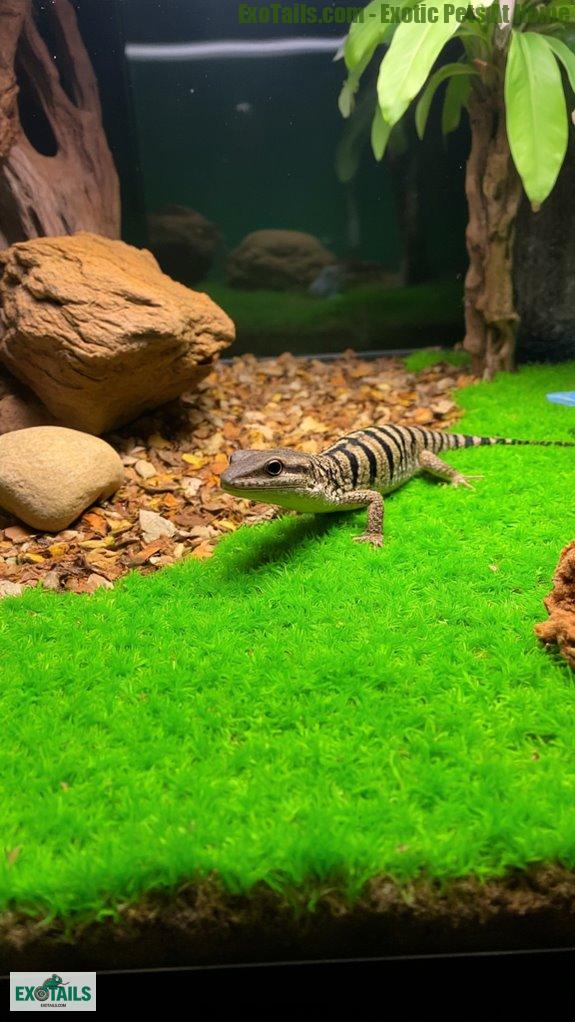
Grass and leaf litter can transform your reptile’s enclosure into a cozy, inviting environment!
I love using grass because it offers amazing benefits, like increased humidity and a naturalistic look. It’s like giving your reptile an outdoor escape right at home.
Plus, leaf litter maintenance is a breeze; just spot clean and replenish as needed.
Have you seen how much your reptile enjoys burrowing and exploring? I’ve witnessed many happy moments while setting up cozy corners in my ExoTails creations.
With these substrates, you’re mastering the art of humidity control while keeping it fun and alive!
Want to join the adventure?
Designing Functional Pet Spaces
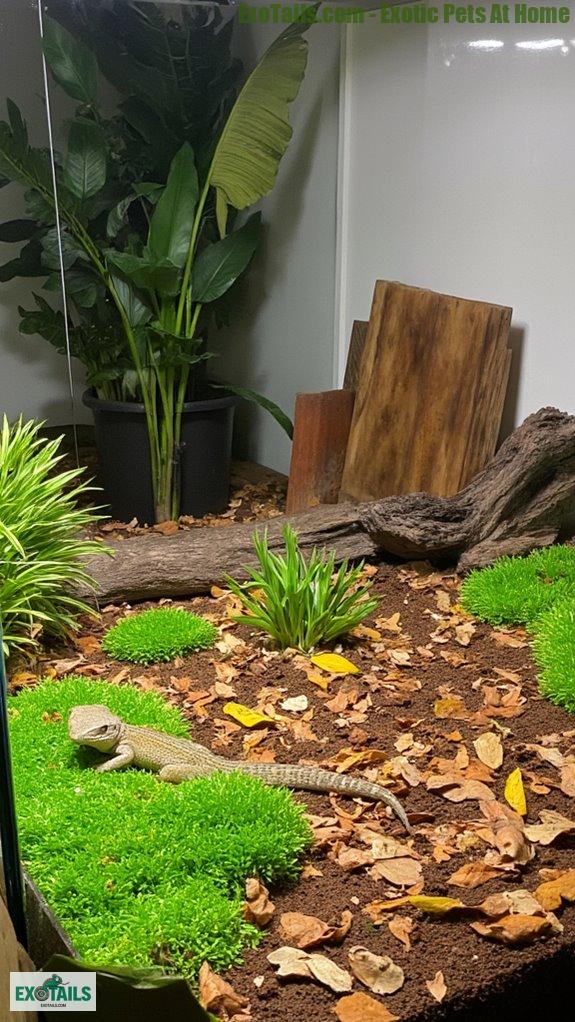
While many people think of reptile enclosures as simple glass boxes, I believe they can be vibrant habitats that are both functional and visually appealing.
Creating natural habitats starts with:
Crafting vibrant natural habitats begins with thoughtful substrate selection and environmental enrichment for our beloved reptiles.
- Choosing suitable substrates for humidity control.
- Incorporating plants for environmental enrichment.
- Designing levels to enrich the space, boosting natural behaviors.
- Optimizing airflow with vents to prevent humidity buildup.
These elements not only enhance the aesthetics but also keep our pets happy and healthy.
Being a reptile enthusiast myself, I created ExoTails to share my passion for transforming living spaces into creature comforts.
Isn’t it fun to think outside the glass box?
Questions and Answers
How Often Should I Replace My Reptile Substrate?
I find that a balanced approach to substrate maintenance frequency helps me determine when to replace it. I usually check every couple of weeks, ensuring it stays clean and fresh for my reptile’s comfort and health.
Can I Mix Different Substrates Together?
I often mix different substrates for varied textures and humidity. Just keep in mind some substrate compatibility tips; it’s essential for maintaining balance. So, I’d recommend following mixing substrates advice carefully to create the perfect environment.
What Are the Signs of Substrate Contamination?
When I notice unusual odors or discolored patches in my substrate types, it’s often a sign of contamination effects. Contaminated substrates can harm my reptiles, so I’m vigilant about their cleanliness and overall quality.
Is It Safe to Use Colored Substrates?
Did you know that 70% of reptile owners prefer natural substrates? While colored substrates can be safe, consider how substrate color impacts your pet’s environment and behavior before making a choice to guarantee ideal colored substrate safety.
How Can I Prevent Mold Growth in Substrates?
I keep mold at bay through good substrate management. I guarantee proper ventilation, maintain ideal humidity levels, and regularly clean the substrate. Staying proactive with these steps makes mold prevention a breeze for my reptiles.







